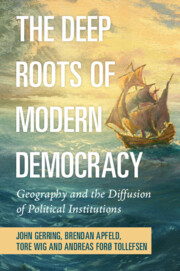Book contents
- The Deep Roots of Modern Democracy
- The Deep Roots of Modern Democracy
- Copyright page
- Dedication
- Contents
- Detailed Contents
- Figures
- Maps
- Tables
- Acknowledgments
- I Introduction
- II Maritime Geography
- III European Diffusion
- 8 Democracy As a European Club
- 9 European Ancestry
- 10 Colonial and Post-colonial Eras
- 11 Global Analyses
- IV Alternate Explanations
- V Conclusions
- Appendix A: Variables
- Glossary
- Bibliography
- Index
10 - Colonial and Post-colonial Eras
from III - European Diffusion
Published online by Cambridge University Press: 01 September 2022
- The Deep Roots of Modern Democracy
- The Deep Roots of Modern Democracy
- Copyright page
- Dedication
- Contents
- Detailed Contents
- Figures
- Maps
- Tables
- Acknowledgments
- I Introduction
- II Maritime Geography
- III European Diffusion
- 8 Democracy As a European Club
- 9 European Ancestry
- 10 Colonial and Post-colonial Eras
- 11 Global Analyses
- IV Alternate Explanations
- V Conclusions
- Appendix A: Variables
- Glossary
- Bibliography
- Index
Summary
Chapter 10 presents case study evidence for the foregoing theory from colonial areas under the control of a single European colonizer. It focuses on four European empires – British, French, Spanish, and Portuguese – because of their extensive historical literatures and because they have the greatest within-empire variation. These cases demonstrate that Europeans brought representative democratic practices (along with their religion, culture, language, and technology) to their colonies and that they spread these institutions where they (Europeans) were sufficiently numerous to control the political outcomes. As a result, democracy became a tool of white supremacy.
- Type
- Chapter
- Information
- The Deep Roots of Modern DemocracyGeography and the Diffusion of Political Institutions, pp. 246 - 286Publisher: Cambridge University PressPrint publication year: 2022

